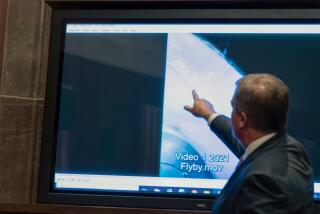Scientists Seek an Out-of-This World ‘Greeting Card’ to Communicate With Aliens
- Share via
DRESDEN, Germany — Scientists have been avidly debating how to communicate with aliens from outer space in a city where a long-distance telephone call to fellow earthlings is hard enough.
Last month’s 41st International Astronautical Congress in Dresden, eastern Germany, was dedicated to ensuring that if little green beings ever show up on telescopes, or doorsteps, we will be prepared.
“We have to assume two things about them: They have radio technology and can count,” said Carl DeVito, a mathematics professor from Arizona University.
The latest IAC, which annually reviews progress in space exploration, evaluated efforts to invent a new language for communicating with creatures from another planet.
Ironically, the scientists chose a venue where the antiquated telephone system of what was formerly East Germany made it difficult to contact families and friends by long-distance phone calls, let alone make contact with aliens.
With their smart Western suits and shiny blue name tags, the scientists themselves stood out like extraterrestrials among the shabbily dressed locals.
The weeklong congress, which was opened by German Science Minister Heinz Riesenhuber, drew thousands of delegates.
Flying saucers may be the stuff of science fiction, but scientists have long presumed that someone else is out there somewhere.
The U.S. Voyager space probe spun off into outer space in the 1970s carrying pictures depicting life on Earth and a recorded message from then U.N. Secretary-General Kurt Waldheim.
There has been no response so far. But Jill Tarter, a scientist from the Search for Extra-Terrestrial Intelligence (SETI) institute, said Earth should start preparing for how to react when we discover we are not alone.
“There’s nobody who writes international greeting cards, but we have to find one for the world,” she told a committee reviewing SETI’s work, which is financed by the National Aeronautics and Space Administration.
Tarter said the U.N. should adopt guidelines telling humans how to approach their first alien.
Her paper admitted that some may think there would be little point to the project.
“In the absence of compelling evidence of an extraterrestrial intelligence, it may be difficult to sustain high-level interest in this issue,” the paper said.
NASA launched an $80-million project in 1982 to transmit signals to aliens in outer space, but scientists at the congress said more taxpayer money was needed to pick up the long-awaited response.
German scientist Sebastien von Hoerner said Earth needs a huge radiotelescope in its southern hemisphere, costing millions of dollars, to speed up the search.
But the hardest part remains unsolved.
“We want to say something but we don’t know how,” DeVito said.
Previous research on communicating with aliens focused on trying to teach extraterrestrials a language. That was the aim of Dutch mathematician Hans Freudenthal, who wrote a book on a “language for cosmic intercourse.”
Despite the promising subject of this pioneering work of the 1960s, DeVito said, its approach was too slow.
It would be quicker to seek common ground with whatever arrived, he said.
“The basic problem is how to get out of our brains and into reality,” he said.
Aliens should be presented with a picture of reality, with captions representing the image in a scientific or mathematical language, he said.
His approach is based on the principle of the Rosetta stone, a plaque found in the Egyptian desert in 1799 by Napoleonic troops.
The stone had Egyptian hieroglyphics translated into two other languages, enabling scholars to decipher the ancient language of the Pharaohs for modern man.
DeVito would first like to confront any little green beings with an image showing an ocean, then an ice field followed by an iceberg. Each picture has a caption.
More to Read
Sign up for Essential California
The most important California stories and recommendations in your inbox every morning.
You may occasionally receive promotional content from the Los Angeles Times.













